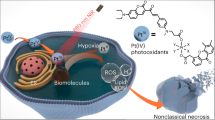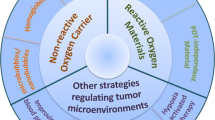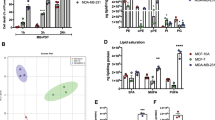Abstract
Photodynamic therapy is a promising antitumor treatment modality approved for the management of both early and advanced tumors. The mechanisms of its antitumor action include generation of singlet oxygen and reactive oxygen species that directly damage tumor cells and tumor vasculature. A number of mechanisms seem to be involved in the protective responses to PDT that include activation of transcription factors, heat shock proteins, antioxidant enzymes and antiapoptotic pathways. Elucidation of these mechanisms might result in the design of more effective combination strategies to improve the antitumor efficacy of PDT. Using DNA microarray analysis to identify stress-related genes induced by Photofrin-mediated PDT in colon adenocarcinoma C-26 cells, we observed a marked induction of heme oxygenase-1 (HO-1). Induction of HO-1 with hemin or stable transfection of C-26 with a plasmid vector encoding HO-1 increased resistance of tumor cells to PDT-mediated cytotoxicity. On the other hand, zinc (II) protoporphyrin IX, an HO-1 inhibitor, markedly augmented PDT-mediated cytotoxicity towards C-26 and human ovarian carcinoma MDAH2774 cells. Neither bilirubin, biliverdin nor carbon monoxide, direct products of HO-1 catalysed heme degradation, was responsible for cytoprotection. Importantly, desferrioxamine, a potent iron chelator significantly potentiated cytotoxic effects of PDT. Altogether our results indicate that HO-1 is involved in an important protective mechanism against PDT-mediated phototoxicity and administration of HO-1 inhibitors might be an effective way to potentiate antitumor effectiveness of PDT.
This is a preview of subscription content, access via your institution
Access options
Subscribe to this journal
Receive 50 print issues and online access
$259.00 per year
only $5.18 per issue
Buy this article
- Purchase on Springer Link
- Instant access to full article PDF
Prices may be subject to local taxes which are calculated during checkout






Similar content being viewed by others
Abbreviations
- CO:
-
carbon monoxide
- COX:
-
cyclooxygenase
- DFO:
-
desferrioxamine
- HO-1:
-
heme oxygenase-1
- Hsp:
-
heat shock protein
- PBS:
-
phosphate-buffered saline
- PDT:
-
photodynamic therapy
- ROS:
-
reactive oxygen species
- SOD:
-
superoxide dismutase
- Zn(II)PPIX:
-
zinc (II) propoporphyrin IX
References
Abels C . (2004). Photochem Photobiol Sci 3: 765–771.
Almeida RD, Manadas BJ, Carvalho AP, Duarte CB . (2004). Biochim Biophys Acta 1704: 59–86.
Bachowski GJ, Korytowski W, Girotti AW . (1994). Lipids 29: 449–459.
Balla G, Jacob HS, Balla J, Rosenberg M, Nath K, Apple F et al. (1992). J Biol Chem 267: 18148–18153.
Berberat PO, Dambrauskas Z, Gulbinas A, Giese T, Giese N, Kunzli B et al. (2005). Clin Cancer Res 11: 3790–3798.
Bressoud D, Jomini V, Tyrrell RM . (1992). J Photochem Photobiol B 14: 311–318.
Castano AP, Demidova TN, Hamblin MR . (2004). Photodiagn Photodyn Ther 1: 279–293.
Cisowski J, Loboda A, Jozkowicz A, Chen S, Agarwal A, Dulak J . (2005). Biochem Biophys Res Commun 326: 670–676.
Deshane J, Wright M, Agarwal A . (2005). Acta Biochim Pol 52: 273–284.
Dolgachev V, Oberley LW, Huang TT, Kraniak JM, Tainsky MA, Hanada K et al. (2005). Biochem Biophys Res Commun 332: 411–417.
Dore S, Takahashi M, Ferris CD, Zakhary R, Hester LD, Guastella D et al. (1999). Proc Natl Acad Sci USA 96: 2445–2450.
Dougherty TJ, Gomer CJ, Henderson BW, Jori G, Kessel D, Korbelik M et al. (1998). J Natl Cancer Inst 90: 889–905.
Dulak J, Jozkowicz A . (2003). Acta Biochim Pol 50: 31–47.
Dulak J, Jozkowicz A, Foresti R, Kasza A, Frick M, Huk I et al. (2002). Antioxidant Redox Signal 4: 229–240.
Fang J, Sawa T, Akaike T, Greish K, Maeda H . (2004). Int J Cancer 109: 1–8.
Ferrario A, Von Tiehl K, Wong S, Luna M, Gomer CJ . (2002). Cancer Res 62: 3956–3961.
Ferrario A, von Tiehl KF, Rucker N, Schwarz MA, Gill PS, Gomer CJ . (2000). Cancer Res 60: 4066–4069.
Frankel D, Mehindate K, Schipper HM . (2000). J Cell Physiol 185: 80–86.
Golab J, Nowis D, Skrzycki M, Czeczot H, Baranczyk-Kuzma A, Wilczynski GM et al. (2003). J Biol Chem 278: 407–414.
Golab J, Olszewska D, Mroz P, Kozar K, Kaminski R, Jalili A et al. (2002). Clin Cancer Res 8: 1265–1270.
Golab J, Wilczynski G, Zagozdzon R, Stoklosa T, Dabrowska A, Rybczynska J et al. (2000). Br J Cancer 82: 1485–1491.
Gomer CJ, Luna M, Ferrario A, Rucker N . (1991). Photochem Photobiol 53: 275–279.
Gomer CJ, Ryter SW, Ferrario A, Rucker N, Wong S, Fisher AM . (1996). Cancer Res 56: 2355–2360.
Granville DJ, Carthy CM, Jiang H, Levy JG, McManus BM, Matroule JY et al. (2000). Blood 95: 256–262.
Granville DJ, Jiang H, An MT, Levy JG, McManus BM, Hunt DW . (1999). Br J Cancer 79: 95–100.
Grune T, Klotz LO, Gieche J, Rudeck M, Sies H . (2001). Free Radic Biol Med 30: 1243–1253.
Hendrickx N, Volanti C, Moens U, Seternes OM, de Witte P, Vandenheede JR et al. (2003). J Biol Chem 278: 52231–52239.
Jalili A, Makowski M, Switaj T, Nowis D, Wilczynski GM, Wilczek E et al. (2004). Clin Cancer Res 10: 4498–4508.
Kapitulnik J . (2004). Mol Pharmacol 66: 773–779.
Keyse SM, Tyrrell RM . (1989). Proc Natl Acad Sci USA 86: 99–103.
Kick G, Messer G, Plewig G, Kind P, Goetz AE . (1996). Br J Cancer 74: 30–36.
Kliukiene R, Maroziene A, Nivinskas H, Cenas N, Kirveliene V, Juodka B . (1997). Biochem Mol Biol Int 41: 707–713.
Koukourakis MI, Giatromanolaki A, Skarlatos J, Corti L, Blandamura S, Piazza M et al. (2001). Cancer Res 61: 1830–1832.
Lee PJ, Alam J, Wiegand GW, Choi AM . (1996). Proc Natl Acad Sci USA 93: 10393–10398.
Lin F, Girotti AW . (1996). Cancer Res 56: 4636–4643.
Luna MC, Wong S, Gomer CJ . (1994). Cancer Res 54: 1374–1380.
Makowski M, Grzela T, Niderla J, M LA, Mroz P, Kopee M et al. (2003). Clin Cancer Res 9: 5417–5422.
McBride G . (2002). J Natl Cancer Inst 94: 1740–1742.
Minetti M, Mallozzi C, Di Stasi AM, Pietraforte D . (1998). Arch Biochem Biophys 352: 165–174.
Motterlini R, Foresti R, Bassi R, Calabrese V, Clark JE, Green CJ . (2000). J Biol Chem 275: 13613–13620.
Nowis D, Makowski M, Stoklosa T, Legat M, Issat T, Golab J . (2005). Acta Biochim Pol 52: 339–352.
Oberdanner CB, Plaetzer K, Kiesslich T, Krammer B . (2005). Photochem Photobiol 81: 609–613.
Pham CG, Bubici C, Zazzeroni F, Papa S, Jones J, Alvarez K et al. (2004). Cell 119: 529–542.
Poss KD, Tonegawa S . (1997). Proc Natl Acad Sci USA 94: 10925–10930.
Rasch MH, Tijssen K, Lagerberg JW, Corver WE, VanSteveninck J, Dubbelman TM . (1997). Photochem Photobiol 66: 209–213.
Ryter SW, Otterbein LE . (2004). Bioessays 26: 270–280.
Sahoo SK, Sawa T, Fang J, Tanaka S, Miyamoto Y, Akaike T et al. (2002). Bioconjug Chem 13: 1031–1038.
Sharman WM, Allen CM, van Lier JE . (2000). Methods Enzymol 319: 376–400.
Shibahara S, Muller RM, Taguchi H . (1987). J Biol Chem 262: 12889–12892.
Shiraishi F, Visner GA, Nick HS, Agarwal A . (2001). Anal Biochem 289: 303–305.
Srivastava M, Ahmad N, Gupta S, Mukhtar H . (2001). J Biol Chem 276: 15481–15488.
Stocker R, Yamamoto Y, McDonagh AF, Glazer AN, Ames BN . (1987). Science 235: 1043–1046.
Tanaka S, Akaike T, Fang J, Beppu T, Ogawa M, Tamura F et al. (2003). Br J Cancer 88: 902–909.
Turkseven S, Kruger A, Mingone CJ, Kaminski P, Inaba M, Rodella LF et al. (2005). Am J Physiol Heart Circ Physiol 289: H701–H707.
Verwanger T, Sanovic R, Aberger F, Frischauf AM, Krammer B . (2002). Int J Oncol 21: 1353–1359.
Wagener FA, Volk HD, Willis D, Abraham NG, Soares MP, Adema GJ et al. (2003). Pharmacol Rev 55: 551–571.
Wang HP, Hanlon JG, Rainbow AJ, Espiritu M, Singh G . (2002). Photochem Photobiol 76: 98–104.
Wild PJ, Krieg RC, Seidl J, Stoehr R, Reher K, Hofmann C et al. (2005). Mol Cancer Ther 4: 516–528.
Woods JA, Traynor NJ, Brancaleon L, Moseley H . (2004). Photochem Photobiol 79: 105–113.
Xue LY, Qiu Y, He J, Kung HJ, Oleinick NL . (1999). Oncogene 18: 3391–3398.
Zhuang S, Kochevar IE . (2003). Photochem Photobiol 78: 361–371.
Acknowledgements
This work was supported in part by Grants: 1M19/M2, 1M19/NK and 1M19/W1 from the Medical University of Warsaw; Grants PBZ-KBN-107-/P04/2004 and PBZ-KBN-091/P05/54 from the State Committee for Scientific Research, Poland. Marcin Makowski is a recipient of the Foundation for Polish Science Award.
Author information
Authors and Affiliations
Corresponding author
Rights and permissions
About this article
Cite this article
Nowis, D., Legat, M., Grzela, T. et al. Heme oxygenase-1 protects tumor cells against photodynamic therapy-mediated cytotoxicity. Oncogene 25, 3365–3374 (2006). https://doi.org/10.1038/sj.onc.1209378
Received:
Revised:
Accepted:
Published:
Issue Date:
DOI: https://doi.org/10.1038/sj.onc.1209378
Keywords
This article is cited by
-
Recent advances in therapeutical applications of the versatile hydroxypyridinone chelators
Journal of Inclusion Phenomena and Macrocyclic Chemistry (2022)
-
A first principle study of heme molecule as an active adsorbent for halogenated hydrocarbons
Journal of Molecular Modeling (2021)
-
HO-1 drives autophagy as a mechanism of resistance against HER2-targeted therapies
Breast Cancer Research and Treatment (2020)
-
Grass carp (Ctenopharyngodon idella) NRF2 alleviates the oxidative stress and enhances cell viability through upregulating the expression of HO-1
Fish Physiology and Biochemistry (2020)
-
A review on heme oxygenase-1 induction: is it a necessary evil
Inflammation Research (2018)



